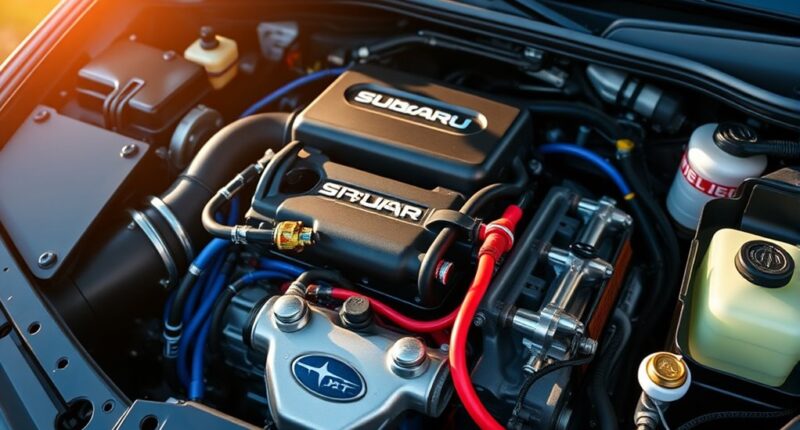To implement flex fuel on your DIT Subaru without triggering CELs, you need a compatible ethanol content sensor that properly fits your fuel tank, connects securely through a dedicated wiring harness, and communicates accurately with your ECU. Calibration is essential; confirm the ECU recognizes ethanol blends by using appropriate tuning or aftermarket flashes. Regularly inspect the sensor and wiring for damage or dirt, and stay attentive to system updates. Keep going to learn more tips for a smooth flex fuel setup.
Key Takeaways
- Use a compatible ethanol content fuel sensor designed for Subaru tanks to ensure accurate readings.
- Correctly wire the sensor with proper gauge wiring, following manufacturer instructions, and secure connections to prevent errors.
- Calibrate the ECU or use aftermarket tuning solutions to recognize ethanol content and avoid triggering CELs.
- Regularly inspect and maintain the sensor and wiring to ensure reliable operation and prevent false CELs.
- Opt for high-quality components and proper installation techniques to ensure system stability and emission compliance.

If you’re looking to boost your Subaru’s performance and fuel flexibility, implementing a flex fuel system can be a smart upgrade. A flex fuel setup allows you to run your DIT Subaru on E85 ethanol, regular gasoline, or a blend of both, giving you more options and potentially increasing power and efficiency. The key to a successful conversion without triggering check engine lights (CELs) lies in proper installation and calibration, especially when it comes to integrating the fuel sensor and wiring harness.
The fuel sensor is the heart of a flex fuel system. It’s responsible for detecting the ethanol content in your fuel and relaying that data to your engine control unit (ECU). To avoid CELs, you need a high-quality sensor compatible with your Subaru’s fuel tank and fuel system. Proper placement and secure wiring are essential. When installing the sensor, ensure it’s seated correctly and that the wiring harness connecting it to your ECU is free of corrosion and damage. A robust wiring harness guarantees consistent signal transmission, preventing false readings that could trigger CELs or cause poor engine performance.
A high-quality, properly installed fuel sensor ensures accurate readings and prevents CELs in your flex fuel Subaru system.
Speaking of wiring, the wiring harness is critical for seamless communication between the fuel sensor, ECU, and other system components. You should use a harness designed explicitly for flex fuel conversions, with proper gauge wiring to handle the sensor’s signals. When wiring the sensor, follow the manufacturer’s instructions meticulously, making sure that all connections are insulated and secured. This prevents electrical noise or shorts that might cause false sensor readings or CELs. If you’re comfortable with wiring work, double-check all connections with a multimeter before reassembling everything. If not, consulting a professional or using a pre-made harness can save time and ensure reliability.
Once the sensor and wiring harness are installed correctly, you’ll need to calibrate your ECU to recognize ethanol content accurately. Many aftermarket tuning solutions or ECU flash tunes include flex fuel support, allowing you to set thresholds for ethanol percentage. Proper calibration ensures your Subaru’s engine management system adjusts fuel delivery and ignition timing appropriately, avoiding running too lean or too rich, which can cause CELs or engine damage. Regular maintenance and inspection of the sensor, wiring, and connections are also crucial, as air quality can impact sensor performance, especially in urban environments with pollution. Maintaining a clean, error-free system; this means periodically inspecting the sensor, wiring, and connections for any issues, especially if you notice any drivability concerns.
Frequently Asked Questions
Can I Run E85 Fuel on a Stock DIT Subaru Without Modifications?
You might be able to run E85 on your stock DIT Subaru without modifications, but it depends on your fuel system and engine tuning. E85 requires more fuel volume, so your fuel injectors and fuel pump need to handle the increased flow. Without proper engine tuning, you risk running lean or damaging your engine. It’s best to upgrade your fuel system and tune your ECU for peak performance and reliability when using E85.
How Does Flex Fuel Affect the Vehicle’S Warranty?
Think of your vehicle’s current question as a game of chess. Flex fuel can impact your manufacturer warranty and dealer policies, as some manufacturers might see modifications as voiding coverage. While running E85 may be fine if you stay within stock parameters, pushing beyond can risk warranty claims. Always check with your dealer first, because, unlike a vintage car, modern warranties are sensitive to alterations.
What Are the Long-Term Impacts of Using Flex Fuel on Engine Components?
Using flex fuel can impact your engine’s long-term health by affecting fuel system longevity and engine wear. You might notice increased corrosion or deposits if your fuel system isn’t properly maintained, which could accelerate wear on components like injectors or valves. However, if you monitor fuel quality and keep up with regular maintenance, you can mitigate these risks and help ensure your engine stays reliable over time.
Is There a Specific Fuel Mixture Sensor Required for Accurate E85 Detection?
Did you know that proper fuel mixture sensors can boost calibration accuracy by up to 30%? For accurate E85 detection, you need specialized fuel mixture sensors designed for flex fuel systems. These sensors guarantee correct fuel-to-air ratios, preventing issues like misfires or power loss. Using the right sensor helps maintain ideal engine performance and longevity, especially when switching between regular and ethanol fuels in your vehicle.
How Does Ambient Temperature Influence E85 Fuel Performance in a DIT Subaru?
Ambient temperature considerably influences E85 fuel performance because it affects fuel volatility. When temperatures are high, E85 becomes more volatile, which can lead to inconsistent fueling and potential power loss. Conversely, cold weather reduces volatility, making combustion less efficient. You should monitor how ambient temperature impacts your vehicle’s fueling, especially with flex fuel systems, to guarantee ideal performance and prevent issues associated with fuel volatility changes.
Conclusion
Now that you’ve set up your DIT Subaru for flex fuel, the potential is huge—more power, better efficiency, and fuel flexibility. But don’t forget, tuning and monitoring are essential to guarantee everything runs smoothly. As you push your car further, unexpected challenges might pop up. Are you ready to explore the full limits of your build? The journey has just begun, and the road ahead promises surprises you won’t want to miss.










